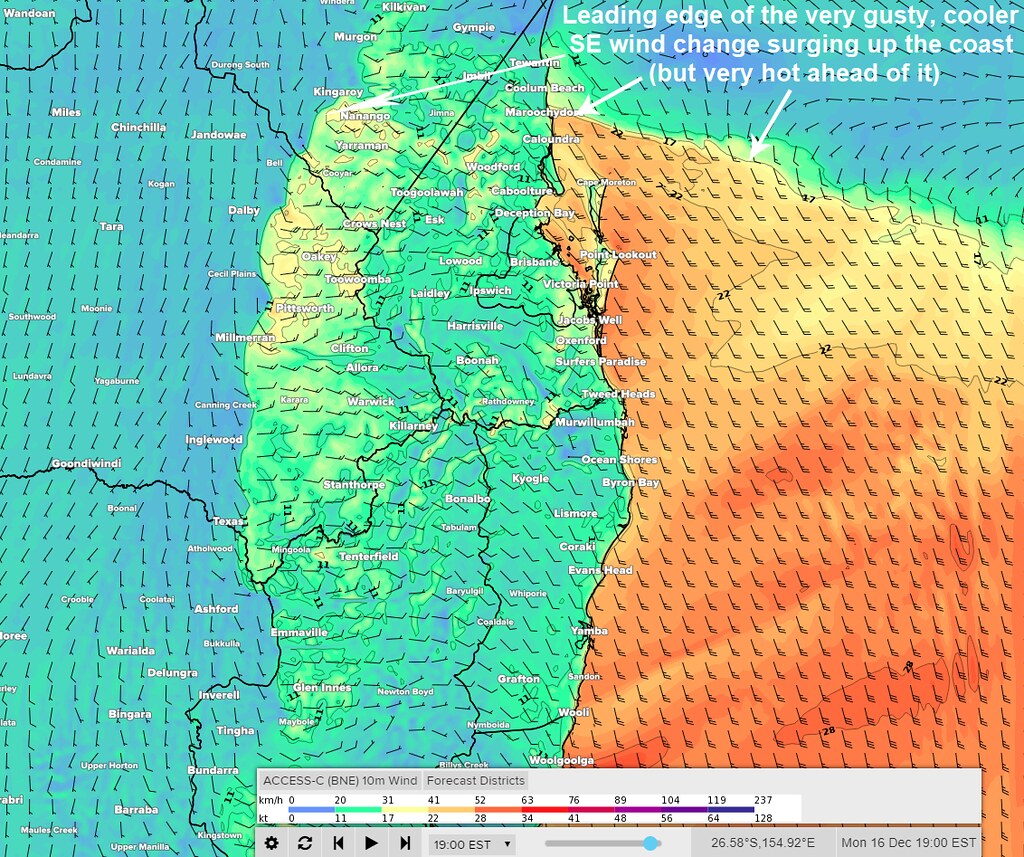

I finally had enough time to do a detailed write-up about Monday and posted it elsewhere so will copy and paste part of it here.
I should point out that Monday’s hot max temps are a bit tricky to forecast for some SEQ locations depending on the timing of the change and seabreeze.
After a very hot day on Monday in SEQ (daytime max temps could be close to 10C hotter than the Dec average away from the coast and may even come close to breaking records in some locations), the good news is that a very gusty, cooler (read: less hot) SE wind change will start surging up the coast on Monday afternoon and bring down max temps closer to the Dec average for a few days although moreso near the coast. It’s unlikely to get as hot for parts of the coastal fringe and islands due to moderation by the afternoon seabreeze but it’s still likely to be significantly hotter than average.
Now for the bad news. Fire danger is expected to increase significantly on Monday in southeastern QLD especially the Downs and the wind change later in the day could pose an extra challenge for firefighters trying to control any existing or new fires.
Also later this week and into the early part of the weekend, max temps are likely to gradually heat up again especially inland and become hotter than the December average…. and on top of that, modelling is still going for the overall very dry weather pattern to continue through most of this week into the weekend for SEQ…. with the recent thunderstorms for the places that got them, only being a brief interruption to this regime. Jan and Feb currently have more uncertainty to them however.
So far this month, every day out of the past 34 days in Brisbane has featured max temps warmer than their respective monthly average and 10 of those have been more than 4C above average. Min temps have been more of a mixed bag although on average, they too have been a bit above the monthly mean.
And now for some good news again. At this stage, SEQ appears likely to be spared the worst of the extreme heat about to spread across large areas of the continent this week (this heat is likely to challenge or break records across a big number of locations where temps are likely to reach into the top 1% of hottest Dec days in the past).... as long as our region has N to NE winds rather than hotter westerly winds from inland keeping out the afternoon seabreezes.
CAUSE:
* The cause of our heat on Monday is warm NW winds followed by SW winds coming up from inland and keeping the seabreeze out from all but near-coastal areas before the cooler change surges up. The airmass itself is also generally very warm through the low to middle atmosphere.
* The reason why Monday’s max temps are a bit tricky to forecast for some locations is because they partly depend on the timing of the cooler coastal wind change and the position of the afternoon seabreeze front. This can make the difference between forecast max temps being spot on… or a number of degrees in error.
Brisbane is especially notorious for being tricky to forecast max temps for on hot days because of its location where even just a small difference in the timing of the seabreeze can make a big difference to whether or not the forecast max temp is reached before the seabreeze comes in.
* Forecast confidence is higher for locations away from the leading edge of the seabreeze and the wind change by the time peak heating’s reached during the day.
THE GUSTY COOLER CHANGE:
* At time of writing, modelling suggests the change is likely to reach the southern Gold Coast in the early afternoon, the Brisbane area around mid afternoon, and the Sunshine Coast in the late afternoon… but allow a bit of leeway for the timings there.
* Many of you might also notice it suddenly become quite windy as the change surges through and some of the gusty winds may hang around at times during the day on Tuesday as well.
* It’s hard to say whether a roll cloud will form along the leading edge of the coastal change but if any of you do manage to take a photo of one, please share!
MAX TEMPS:
* Monday's max temps are likely to range from the low 40s at inland locations east of the ranges, the high 30s between inland and coastal areas, and low to mid 30’s near the coastal fringe…. but remember that it’s possible some of these may be in error for locations near the leading edge of the seabreeze or coastal change if either arrives earlier or later than expected.
The map above via Weatherzone shows the forecast wind speeds and directions from the ACCESS-C model for early Monday evening.
P.S. the first image is the 2-week max temp scenarios for Amberley from the NCEP ensemble.

